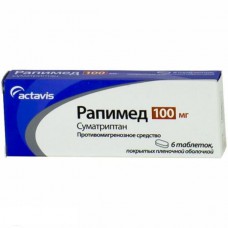Expiration date: 08/2026
Clinico-pharmacological group
(Agonist of serotonin 5-HT1-receptors. The drug protivomigrenoznoe activity)
Release form, composition and packaging
Tablets, film-coated white color, oval, lenticular, scored on both sides and on the side, engraved with "SN" on one side and "50" on the other.
Excipients: lactose monohydrate 70 mg, croscarmellose sodium 6 mg, lactose anhydrous (Pharmatose DCL 21) - 105.7 mg, cellulose microcrystalline (PH 102 Avicel) - 45.3 mg, magnesium stearate - 3 mg.
The composition of the film shell: lactose monohydrate - 4.32 mg mannitol - 2.76 mg titanium dioxide 2.4 mg talc - 1.8 mg, triacetin - 720 micrograms.
2 PCs. - blisters (1) - packs of cardboard.
3 PCs. - blisters (1) - packs of cardboard.
3 PCs. - blisters (2) - packs of cardboard.
3 PCs. - blisters (4) - packs of cardboard.
3 PCs. - blisters (6) - packs cardboard.
3 PCs. - blisters (8) - packs of cardboard.
Tablets, film-coated white color, oval, lenticular, with engraving "SN" on one side and "100" on the other.
1 tablet contains:
sumatriptan succinate 70 mg,
that corresponds to the content of sumatriptan 50 mg
Excipients: lactose monohydrate and 140 mg croscarmellose sodium 12 mg, lactose anhydrous (Pharmatose DCL 21) - 211.4 mg, cellulose microcrystalline (PH 102 Avicel) - 90.6 mg, magnesium stearate - 6 mg.
Shell composition: lactose monohydrate - 8.64 mg, mannitol - 5.52 mg, titanium dioxide - 4.8 mg, talc - 3.6 mg, triacetin - 1.44 mg.
Pharmacological action
Protivomigrenosny drug. Specific selective agonist of serotonin 5-HT1D (5-hydroxytryptamine 1D subtype) receptors localized mainly in blood vessels of the brain, has no effect on other subtypes of the serotonin 5-HT receptors (5-HT2 5-HT7). Causes vasoconstriction of the carotid arterial bed, which supply blood to extracranial and intracranial tissues (expansion of blood vessels of the meninges and/or swelling is the main mechanism of development of migraine in humans) without significant effect on cerebral blood flow. Inhibits the activity of receptor endings of the afferent fibers of the trigeminal nerve in the Dura mater (resulting in a decrease in the allocation of sensory cortex). Both of these effects can be the basis of the protivomigrenoznogo of sumatriptan.
Addresses associated with migraine attack with nausea and photophobia.
In 50-70% cases quickly resolves the attack when administered in a dose of 25-100 mg. for 24 hours in 1/3 of cases may develop a recurrence requiring re-application.
The clinical effect is usually observed within 30 minutes after ingestion.
Pharmacokinetics
Suction
After intake of rapidly absorbed from the gastrointestinal tract. After 45 min the concentration of sumatriptan in plasma reaches 70% of Cmax. Bioavailability of 14% (due to presystemic metabolism and incomplete absorption). After ingestion of sumatriptan in a dose of 100 mg Cmax in the blood plasma is 54 ng/ml.
Distribution
The plasma protein binding is 14-21%. Common Vd - 170 liter (2.4 l/kg).
Metabolism
Metabolized by oxidation with the participation of MAO (mainly isozyme A) with the formation of the main metabolite - endoglucanase analogue of sumatriptan, which do not possess pharmacological activity against serotonin 5-HT1 and 5-HT2 receptors.
Excretion
T1/2 of sumatriptan is about 2 h. Plasma clearance is 1160 ml/min, kidney klirens - 260 ml/min, extrarenal clearance - 80% of total clearance.
Excreted by the kidneys, mainly as metabolites (97% after ingestion) is a free acid or as glucuronide conjugate.
Dosage
The drug is taken orally. The tablet should be swallowed whole with water.
Treatment is initiated as early as possible after the occurrence of a migraine attack (although the drug is effective at any stage of the attack).
For the relief of acute migraine attacks is recommended disastrously - 50 mg 1 times/day. Some patients may require higher dose of 100 mg. If the symptoms do not disappear or shrink after taking the first dose, for the relief of jaristea re-take the drug should not be. However, the drug can be used for the relief of subsequent migraine attacks.
If the patient felt improvement after the first dose, then the symptoms resumed, you can take a second dose within 24 h with an interval of at least 2 h after the first dose. The maximum dose of sumatriptan 300 mg in 24 hours.
Overdose
Symptoms: ingestion of 400 mg is not observed any other adverse reactions, in addition to the previously listed.
Treatment: symptomatic therapy, monitor the patient for at least 10 h. No data on the effect of hemodialysis or peritoneal dialysis on the concentration of sumatriptan in plasma.
Drug interactions
Not observed interaction of sumatriptan with propranolol, flunarizine, pizotifen and ethyl alcohol.
Simultaneous administration with ergotamine and medications ergotaminsoderjasimi possible long-term spasm of the vessels. Sumatriptan may be administered no earlier than 24 h after administration of preparations containing ergotamine and Vice versa, drugs, containing ergotamine, you can assign no earlier than 6 h after administration of sumatriptan.
Perhaps the interaction between sumatriptanom and MAO inhibitors (to decrease the intensity of metabolism of sumatriptan, increasing its concentration).
May develop serotonin syndrome with coadministration of sumatriptan and drugs from the group of SSRIs and Yassin.
Increases the likelihood of side effects when co-administered sumatriptan drugs zveroboynogo.
Pregnancy and lactation
The drug is contraindicated during pregnancy and lactation (breastfeeding).
Side effects
Common reactions: pain, sensation of heat or tingling, a sense of compression or gravity. These symptoms are usually transient but may be intense and occur in any part of the body, including the chest and throat. Hot flashes, dizziness, feeling of weakness, tiredness, drowsiness usually slightly or moderately expressed and are transient in nature.
From the side of cardiovascular system: decrease in blood pressure, transient increase in blood pressure (observed soon after administration of the sumatriptan), bradycardia, tachycardia (including ventricular), arrhythmia, angina, cardiac arrhythmia, transient ECG changes in the ischemic-type, myocardial infarction, spasm of the coronary arteries, in a few cases - Raynaud's syndrome.
From the digestive system: nausea, vomiting, ischemic colitis (the relationship of these side effects with sumatriptan has not been established), dysphagia, discomfort in the abdomen.
Movement disorders: a feeling of tightness (these symptoms are usually transient but may be intense and occur in any part of the body including chest and throat), tremor, rigidity of muscles of nape.
From the nervous system: sensory disturbance including paraesthesia, seizures (in some cases they were observed in patients with a history of seizures or with conditions predisposing to seizures in some patients predisposing factors have been identified), dystonia.
From the sensory organs: diplopia, flashing "flies" before the eyes, nystagmus, scotoma, reduced visual acuity. Rarely develops partial temporary loss of vision. However, it should be borne in mind that visual disturbances can be associated with migraine attacks.
Allergic reactions: skin rash (including urticaria and erythematous rash), itching, anaphylactic reactions.
From the laboratory parameters: minor changes in liver transaminases.
The respiratory system: shortness of breath, nasal bleeding.
Terms and conditions storage
The drug should be stored out of reach of children, dry, protected from light place at temperature not exceeding 30°C. shelf Life - 3 years.
Testimony
- migraine (mild asthma, with aura or without it).
Contraindications
- hemiplegic, basilar or oftalmologicheskiy forms of migraine,
- coronary heart disease (including suspected it),
- angina (including Prinzmetal),
- myocardial infarction (including history),
- myocardial infarction,
- uncontrolled hypertension,
- occlusive peripheral vascular disease,
- stroke or transient ischemic disorders of cerebral circulation (including in history),
- reception simultaneously with ergotamine or its derivatives (including metisergid),
- use in patients receiving MAO inhibitors or earlier than 2 weeks after the cancellation of these drugs,
- expressed violation of the liver and/or kidneys
- child and adolescence to 18 years,
- elderly age (over 65 years),
- pregnancy,
- lactation (within 24 h after administration of the drug),
- hypersensitivity to the drug.
With caution:
- epilepsy (including any condition with reduced seizure threshold),
- controlled hypertension,
- violation of the liver and kidneys,
- patients with hypersensitivity to sulfonamides(possible allergic reaction and the severity from cutaneous manifestations to anaphylaxis).
Special instructions
Sumatriptan should be used only in the case if the diagnosis of migraine is not in doubt, thus it should be applied as early as possible after the start of a migraine attack, although it is equally effective when used at any stage of the attack.
The drug is not intended to prevent migraines (administration during a migraine aura prior to the occurrence of other symptoms may not prevent the development of headaches).
As the use of other protivomigrenozhnykh of funds, the appointment of sumatriptan in patients with previously diagnosed migraine or in patients with atypical migraine to exclude other potentially serious neurological conditions. It should be noted that patients with migraine increased risk of cerebrovascular complications (stroke or transient disorders of cerebral circulation).
In patients at risk from cardiovascular system therapy do not begin without preliminary survey (women in post-menopausal stages, men over the age of 40 years, persons with risk factors for coronary heart disease). The survey does not always allows to identify heart disease in some patients. In very rare cases, patients may experience serious adverse reactions from the cardiovascular system, a history which was not observed cardiovascular pathology. After taking the drug may experience temporary intense pain and tightness in the chest, extending to the neck. If there is reason to assume that these symptoms are manifestations of ischemic heart disease, it is necessary to conduct appropriate diagnostic tests.
Should be administered with caution to patients with controlled arterial hypertension, since in some cases there was observed a transient increase in blood pressure and peripheral vascular resistance, patients suffering from such diseases which might significantly change absorption, metabolism or excretion of sumatriptan (e.g. impaired renal function or liver).
There are very rare reports about the development of serotonin syndrome (including mental disorders, autonomic instability and neuromuscular disorders) after administration of selective inhibitors of serotonin reuptake (SSRI) and sumatriptan. About the development of serotonin syndrome has also been reported with coadministration of triptans and inhibitors of reverse takeover serotonin and noradrenalina (Yassin). In the case of joint SSRI/Yassin and sumatriptan should be closely monitored for this group of patients.
Sumatriptan should be used with caution in patients with epilepsy and organic lesions of the brain in anamnesis with a reduction in the threshold of convulsive readiness.
In patients with hypersensitivity to sulfonamides introduction of sumatriptan can cause allergic reactions, the severity of which varies from cutaneous manifestations to anaphylaxis. Data on cross-sensitivity is limited but caution should be exercised in the appointment of sumatriptan to these patients.
The abuse of pharmaceutical drugs intended for the relief of migraine attacks, associated with increased headaches in sensitive patients (headache associated with the abuse of drugs). Thus it is necessary to consider discontinuation of the drug.
In the absence of effect of the first dose administration should clarify the diagnosis.
Experience with the use of sumatriptan in patients over 65 years is limited (significant difference in pharmacokinetics compared to younger patients is not observed).
Do not exceed the recommended dose of sumatriptan.
Effects on ability to drive and use machinery
During treatment, patients must be careful when driving and occupation of other potentially hazardous activities, require high concentration and psychomotor speed reactions.


